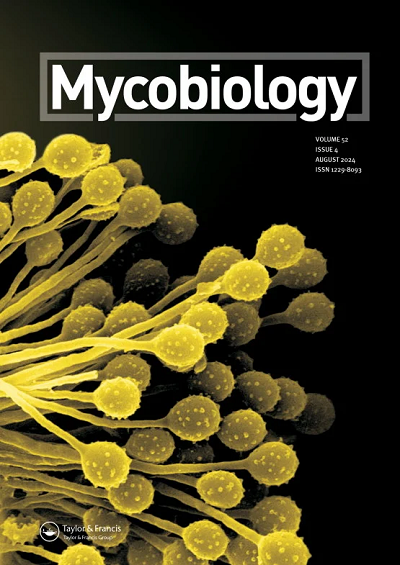Copper Tolerance of Novel Rhodotorula sp. Yeast Isolated from Gold Mining Ore in Gia Lai, Vietnam
IF 1.6
4区 生物学
Q2 AGRONOMY
引用次数: 0
Abstract
In this study, twenty-five yeast strains were isolated from soil samples collected in the gold mining ore in Gia Lai, Vietnam. Among them, one isolate named GL1T could highly tolerate Cu2+ up to 10 mM, and the isolates could also grow in a wide range of pH (3–7), and temperature (10–40 °C). Dried biomass of GL1 was able to remove Cu2+ effectively up to 90.49% with a maximal biosorption capacity of 18.1 mg/g at pH 6, temperature 30 °C, and incubation time 60 min. Sequence analysis of rDNA indicated this strain was closely related to Rhodotorula mucilaginosa but with 1.53 and 3.46% nucleotide differences in the D1/D2 domain of the 28S rRNA gene and the ITS1-5.8S rRNA gene-ITS2 region sequence, respectively. Based on phylogenetic tree analysis and the biochemical characteristics, the strain appears to be a novel Rhodotorula species, and the name Rhodotorula aurum sp. nov. is proposed. This study provides us with more information about heavy metal-tolerant yeasts and it may produce a new tool for environmental control and metal recovery operations.从越南嘉莱金矿分离的新型红酵母对铜的耐受性
本研究从越南嘉莱金矿土壤样品中分离到了25株酵母菌。其中,一株名为GL1T的菌株对Cu2+的耐受性最高可达10 mM,且菌株在pH(3-7)和温度(10 - 40℃)范围内均能生长。在pH为6、温度为30℃、培养时间为60 min的条件下,GL1对Cu2+的吸附效率高达90.49%,最大吸附量为18.1 mg/g。rDNA序列分析表明,该菌株与粘胶红酵母(Rhodotorula mucilaginosa)密切相关,但28S rRNA基因D1/D2结构域和ITS1-5.8S rRNA基因- its2区域序列的核苷酸差异分别为1.53和3.46%。基于系统发育树分析和生物化学特征,该菌株可能是一种新的红torula,并建议命名为Rhodotorula aurum sp. 11 .。该研究为我们提供了更多关于耐重金属酵母的信息,并为环境控制和金属回收作业提供了新的工具。
本文章由计算机程序翻译,如有差异,请以英文原文为准。
求助全文
约1分钟内获得全文
求助全文
来源期刊

Mycobiology
AGRONOMYMYCOLOGY-MYCOLOGY
CiteScore
3.90
自引率
5.30%
发文量
41
审稿时长
22 weeks
期刊介绍:
Mycobiology is an international journal devoted to the publication of fundamental and applied investigations on all aspects of mycology and their traditional allies. It is published quarterly and is the official publication of the Korean Society of Mycology. Mycobiology publishes reports of basic research on fungi and fungus-like organisms, including yeasts, filamentous fungi, lichen fungi, oomycetes, moulds, and mushroom. Topics also include molecular and cellular biology, biochemistry, metabolism, developmental biology, environmental mycology, evolution, ecology, taxonomy and systematics, genetics/genomics, fungal pathogen and disease control, physiology, and industrial biotechnology using fungi.
 求助内容:
求助内容: 应助结果提醒方式:
应助结果提醒方式:


